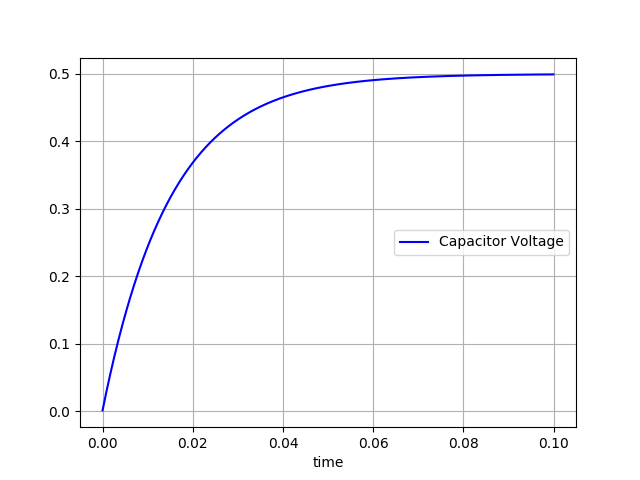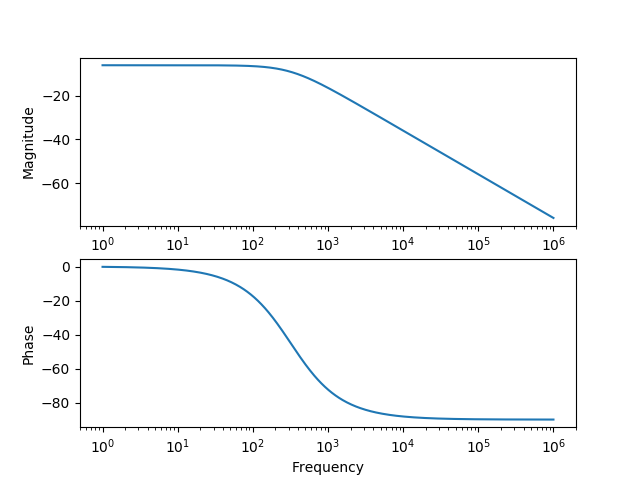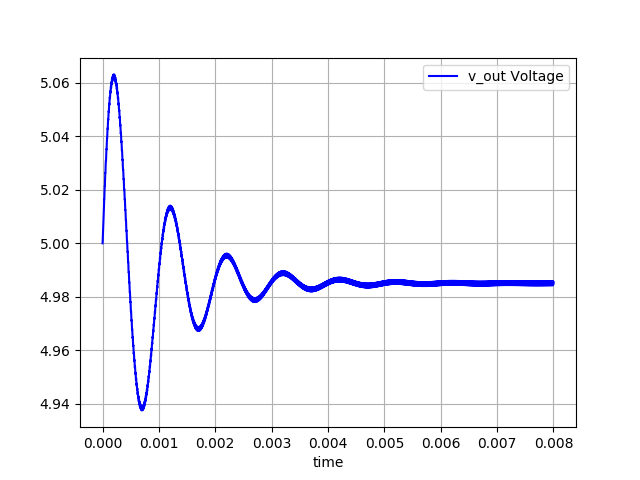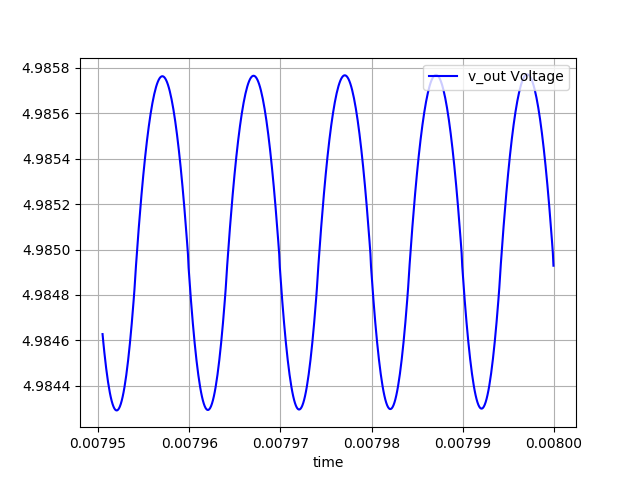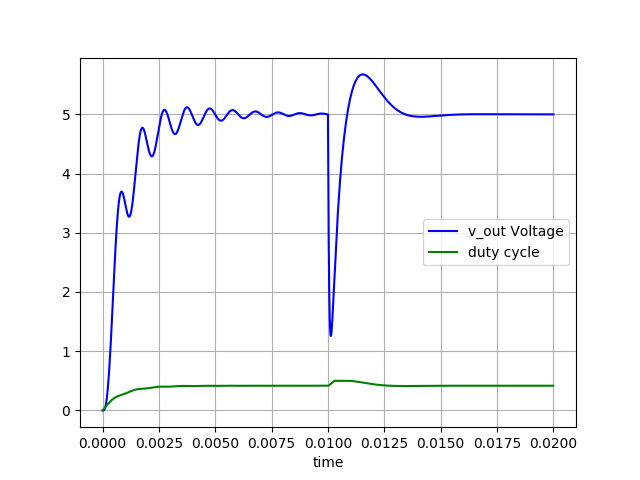- Python 3.5+
- Numpy
- SciPy
See "examples.py" for the full example source code.
import cmath, math
import circuit_sim
from circuit_sim import bode_plot, interpolate, line_chartA resistor divider circuit:
circuit = """
R R1 vcc v_out 1k
R v_out gnd 1kOhm
vcc = 2.5v
"""Circuit Description Language Syntax:
- Component names are optional - the first resistor is called R1, and the second one will get a name automatically assigned to
- The "gnd" is automatically referenced to 0v
- The units like "ohm" and "v" are optional
circuit = circuit_sim.Circuit.build_from_string(circuit)
circuit.dc_analysis()
print("v_out =", circuit.get_variable("v_out")) # 1.25
circuit.print_equations() # (0.002)(v_out) = 0.0025
circuit.print_all_variables() # v_out = 1.25A diode in series with a resistor:
circuit = """
R vcc v1 0.1
D my_diode v1 gnd i0=1e-5 m=3 v0=0.5
vcc = 5v
"""The diode is modeled as I = (i0) * exp[m * (v - v0)]
circuit = circuit_sim.Circuit.build_from_string(circuit)
circuit.dc_analysis()
circuit.print_all_variables()
# v1 = 4.701818974760387
# my_diode.internal_node = 0.33289232252030193
# my_diode.current = 2.981810252396129Using a calculator, you can verify that:
- diode current: 2.982 = 0.00001 * exp ( 3 * (4.70812-0.5))
- resistor current: 2.982 = (5 - 4.70182) / 0.1
An RC circuit being charged:
circuit = """
R vcc v_out 1k
R v_out gnd 1k
C v_out gnd 30uF
vcc = 1V
"""To plot the "v_out":
circuit = circuit_sim.Circuit.build_from_string(circuit)
time_stamps, results = circuit.transient_simulation(0, 100e-3, ["v_out"])
line_chart(x_label="time",
# [ x, y, graph_title ]
data=[time_stamps, results[0], "Capacitor Voltage"],
legend_location="center right")A RC circuit:
circuit = """
R vcc v_out 1k
R v_out gnd 1k
C v_out gnd 1uF
vcc = 1V
"""To make a Bode plot:
circuit = circuit_sim.Circuit.build_from_string(circuit)
freq, results = circuit.ac_sweep(["v_out"])
bode_plot(freq, results[0])Example: buck converter output ripple modeling
A 12v to 5v buck converter model:
circuit = """
VG vg v_sw gnd 12v
L L1 v_sw v_out 50uH v0=0 i0=5
C C1 v_out gnd 500uF v0=5 i0=0
R R_load v_out gnd 1ohm
"""Note the use of initial conditions for "L1" and "C1" to start the buck converter near it's steady state.
A buck converter applies a square wave into an LC circuit.
This is modeled by setting "vg" to 12v, then to 0v, then back to 12v, and so on.
circuit = circuit_sim.Circuit.build_from_string(circuit)
time_stamps, results = circuit.transient_simulation(0, 0, ["v_out"])
on_time = 10e-6 * 5 / 12
off_time = 10e-6 - on_time
for i in range(0, 800):
vg = circuit.get_component_for_modification("vg")
vg.value = 12
circuit.continue_transient_simulation(on_time, time_step=100e-9)
vg = circuit.get_component_for_modification("vg")
# The "get_component_for_modification" needs to be called again
# and again because it registers the "vg" component as having
# been modified.
vg.value = 0
circuit.continue_transient_simulation(off_time, time_step=100e-9)This transient analysis will take some time to run.
The initial conditions put the circuit close to its stead state, but it's not exactly at the steady state. The long transient simulation is to put the model into its steady state.
To see the output voltage during the long transient simulation:
line_chart(x_label="time",
data=[time_stamps, results[0], "v_out Voltage"],
legend_location="upper right")The steady state is not 5v due to approximations used during the transient simulation. The code is using a time step of 100ns, meaning 100 steps per 10us switching cycle. If a smaller time step is used, then the steady state output will be closer to 5v, at a cost of a longer simulation time.
The switching ripple is visible if one zooms into the last few switching cycles:
line_chart(x_label="time",
data=[time_stamps[-500:], results[0][-500:], "v_out Voltage"],
legend_location="upper right")This example is rather long and not all of the code is provided below. The code involves three items:
- the function "digital_buck()" is the example's entry point
- the class "Controller" models the buck converter's digital controller
- the function "run_buck_converter(...)" runs the buck circuit for a single switching cycle
This "README.md" file will only go over "digital_buck()", so import the other two items:
from examples import Controller, run_buck_converterA 12v to 5v buck converter model:
circuit = """
VG vg v_sw gnd 12v
L L1 v_sw v_out 50uH
C C1 v_out gnd 500uF
R R_load v_out gnd 1ohm
"""Unlike in the previous example, the "L1" and "C1" are initialized to close the operating point. In this example, these components start off at 0v.
To prepare for the simulation:
circuit = circuit_sim.Circuit.build_from_string(circuit)
time_stamps, results = circuit.transient_simulation(0, 0, ["v_out"])
duty_cycle_data = []
duty_cycle_data_t = []
controller = Controller(circuit)The duty cycle is not part of the circuit, so a separate list is allocated. The duty cycle is also not sampled at the same rate as the circuit, so a separate "_t" list is used to hold the time stamps. The code inside ""run_buck_converter(...)" simulates the circuit elements using 10 time steps per 10us switching cycle. During this same time period, there is only one duty cycle value, and only one duty timestamp, which is why the "duty_cycle_data[]" list is ten times shorter than the circuit simulation data.
To run the buck converter for 1000 cycles:
# starting condition: 1 ohm load
run_buck_converter(circuit, controller, duty_cycle_data,
duty_cycle_data_t, num_cycles=1000)Next, change the load resistor and then run the buck converter for another 1000 cycles.
# change load to 0.1 ohm
r_load = circuit.get_component_for_modification("R_load")
r_load.value = 0.1
run_buck_converter(circuit, controller, duty_cycle_data,
duty_cycle_data_t, num_cycles=1000)Plot the output voltage:
line_chart(x_label="time",
# [ x, y, graph_title ]
data=[time_stamps, results[0], "v_out Voltage",
duty_cycle_data_t, duty_cycle_data, "duty cycle"],
legend_location="center right")This is bad! Good thing this is a circuit simulator project and not a power supply project...
Improving the control
To keep the example simple, the code inside the "Controller" class is just using proportional control, and it's using voltage mode only.
In addition to more complex compensation schemes, current mode control can be implemented by reading the inductor current, using:
i_L = self.__circuit.get_variable("L1.current")